
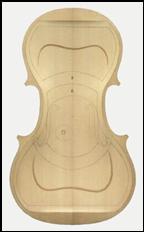
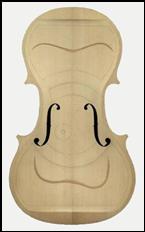
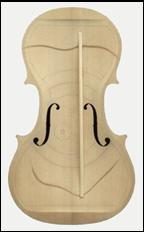
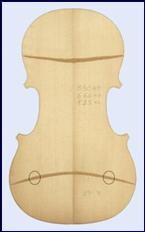
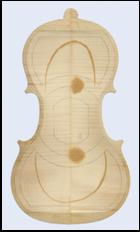
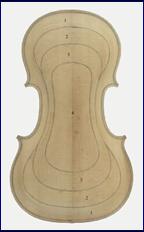
|
What are modes 2 and 5 in violin making?
To repeatably tune the mode 5 frequency (intrados) of the free back and top plates, the frequency of the starting volume (mode 5 of the extrados) must be tuned within the limits indicated in the book’s tables for the wood’s moisture content at the given moment.
When the moisture content in the wood rises or falls, all of these frequencies drop or rise (modes 2 and 5, modes C2, B1-, B1+, A0 and B0) on free materials or instruments in the white and varnished. This is the veritable key to the problem.
Mode 5 nodal lines at different stages of manufacture:
It is practically impossible to obtain the same frequency in the free materials with appropriate thicknesses by reproducing the same arch on all violins, because there is a discrepancy in frequency of up to 100 Hz between the unworked materials being used, for wood of identical dimensions and volume.
This is why different arching profiles of the materials (back and top plates) are systematically obtained for the same tuning frequency of the starting volume (extrados).
Examination of the finest Italian violins reveals that no two arches are identical, not even for the same model. These differences prove that the plate tuning technique was perfectly understood by the Italian makers and that it was adapted to the characteristics of the materials used, and not conditioned by each individual luthier's aesthetic approach.
It would be a serious error and a misinterpretation of the reality of the plate tuning modus operandi to suppose that modifying the thicknesses could yield a correct mode 5 on a free back or top plate.
The starting volume of a top or back plate must not be tuned to the same frequency when the wood has 1% moisture content, as when it registers 12%. Irrespective of the frequency of the free materials, optimization of the starting volume offers the possibility of decreasing the back plate weight to 92 g and the top plate weight to 65 g.
Any material capable of vibrating has a fundamental frequency. With regard to free violin plates, this frequency (mode 5) is the tap tone. The nodal regions of the fundamental frequency can be activated with a frequency generator coupled with a frequency counter or this frequency can be read using FFT software.
Activating the fundamental frequency of a material with a frequency generator enables the violin maker to see the configuration of the nodal and antinodal regions (nodes and antinodes), i.e., the manner in which the material vibrates in different areas between the vibrational nodes.
The pattern of each nodal region is different because it depends on the height the frequency that is activating it. While playing a violin, simply touching the back or top plate suffices to demonstrate that certain regions vibrate while others do not.
The speed of the propagation of sound (celerity) is independent of the nature and form of the initial energy. It depends solely on the milieu through which it is travelling (the nature of the materials, the moisture content, temperature, pressure, strength).
Mode 2 and 5
Mode 2 corresponds to the transverse celerity. It determines the thicknesses at the center of the back and top plates and the transverse curve of the arching of the extrados.
Mode 5 corresponds to the longitudinal celerity and true frequency of the materials, whatever the stage of manufacture. It determines the longitudinal curve of the arching of the extrados.
Together, the two celerities and the density determine the overall performances of the material, the starting volume’s capacity, as well as the height and shape of the arch. Successful back plate tuning depends on the discrepancy between the two celerities. This differential will be all the greater if the moisture is unevenly distributed throughout the wood.
The Italian instrument makers were perfectly aware of the problem posed by the variability of plate frequencies depending on the temperature, ambient humidity, and the season. String players also face this disadvantage when the moisture content of the wood alters the sonority of their instrument. Cellos are the most sensitive to such changes.
The shape and volume of the arching must be optimized for tuning violin top and back plates in a limited, reproducible spectrum, by optimizing the weight of the materials.
It is therefore necessary to know the moisture content in the wood in order to tune free materials without error.
Density, celerity, elasticity, weight and frequency vary, following the curve plotting the materials’ moisture content.
Modern (or baroque) violin plates should be tuned according to the same technique, using a tone generator to visualize the nodal patterns or sound analysis software to tune the materials, by taking into consideration the wood’s moisture content of the moment.
A violin maker who tunes the mode 5 frequency of a free top or back plate without regard for the wood’s moisture content is unlikely to obtain the best results. A satisfactory outcome, if attained, would have little chance of being repeated.
Precaution for violin plate tuning
On free back and top plates in the white at 12% moisture content, frequencies can rise by 42 Hz when the moisture content drops to 0%. It is therefore necessary to know the moisture content in the wood in order to tune free materials without error.
The frequencies are what make the main difference in the violin’s sound. Modifying the thicknesses amounts to modifying the frequency. Damping (mass, spring) is just as important as frequency.
It may be better to have a little too much wood rather than not enough. However, when there is excess wood, there is absorption of energy by the mass. Consequently, the free materials must be tuned not only to an appropriate frequency, but also with correct resistance; i.e., thicknesses in keeping with density, elasticity, and frequency.
This is why it is preferable to set up the violin in the white and wait 20 to 30 days in order to see whether the B1+ frequency rises.
Tuning the fundamental frequency of the materials to a particular frequency by optimizing the weight and the thicknesses allows the highest frequencies to create visible nodal regions. Excess wood (too heavy or too thick) prevents appropriate configuration of the high frequencies’ nodal regions: the vibratory energy generated by the strings is absorbed by the wood.
Certain high frequencies and their overtones will be scarcely audible because they have little energy. A violin with too much wood loses power; the sound envelope is weak (few harmonics), giving
The frequency of the extrados or of the starting volume directly affect but the frequencies of the free back and top plates. These frequencies determine the coupling frequencies of the plates assembled on the ribs, and hence, the B1- and B1+ mode frequencies.
The height of the fundamental frequencies (mode 5) of the free back and top plates determines
A violin’s timbre is independent of its acoustic qualities. When the B1- and B1+ mode frequencies and the delta between them are tuned in an appropriate range of frequencies, violins will have the same acoustic performances, whether the timbre is dark or clear.
To avoid error, a moisture meter –preferably one with a scanner– must be used while tuning the mode 5 of the extrados and intrados. The use of modern devices avoids failures that are due to a rapid change in the moisture content of the wood during the tuning process.
The only real problem in violin making is the back plate.
The lateral edges of nearly all back plates become deformed during sculpture of the extrados or the intrados; sometimes with an accumulation of the two deformations (extrados and intrados).
In most cases, as the surface of the extrados is exposed, the wood dehydrates on that surface only. Dehydration is more rapid on the edges, since they are thinner than the center. The wood retracts, making the lateral edges of the back plate curl upwards.
When this occurs during sculpture of the extrados, the mode 5 frequency of the starting volume and
It is necessary to tune the free back and top plates within the critical limits of the materials in the white after dehydration to 1% moisture content in the wood, but this does not suffice, for the following reasons:
When proper consideration has not been taken of the back plate’s characteristics (the density and elasticity of the wood), deformation of its arch will be observed: it rises under the pressure from the sound post, which itself receives pressure from the strings (12 to 15 kg or 26.5 to 33 pounds).
The B1+ mode frequency rises by 15 to 20 Hz, irrespective of the moisture content. A new violin that sounded very good can become unplayable, when the B1+ mode frequency was previously been tuned to the extreme critical limit. A sound post that is fitted too tightly likewise raises the B1+ mode frequency.
F-holes Elliptical or circular (rosette) openings provide insufficient resistance to air compressed within
Modifying violin sound holes until they formed an “f” shape doubled the acoustic outcome and its efficiency by increasing the pressure of the compressible air volume within the body. The air thus compressed is expelled more rapidly, increasing the air resonance power.
An increase in the length of the f-holes along with a decrease in the width of the opening at the notch within the limit of the diameter of the sound post, baroque or modern– achieved by Guarneri del Gesù, increases acoustic conductance and raises both the A0 mode resonance frequency and the radiated power of the violin.
The theory of fluid dynamics shows that the conductance of an arbitrarily-shaped sound hole is
— In order to tune the A0 cavity mode frequency without a sound post, the area of the f-hole apertures and the overall volume of the sounding box must be calculated.
The f-holes must be opened before gluing the bass bar in place, as the outcome determines the frequency and density of the bass bar.
Smaller f-holes result in a smaller decrease in the “initial” frequency of the top plate once they have been cut. The top plate is stronger, thus enabling the maker to optimize the bass bar in order to raise the frequency of the top plate “with f-holes” back up to its “initial” frequency.
Trace the model of the f-holes on millimetric graph paper and count the squares with the help of a magnifying glass.
For the instrument to have good carrying power, the stream of harmonics leaving the f-holes must not be dispersed in all directions: to this end, the openness of the f-holes must be limited, thus increasing the strength of the top plate and raising the frequency after cutting the f-holes.
Whatever the f-hole model, the distance between the edges of the upper eyes must be between
If the distance between the upper eyes is less than 40 mm, the mode 1 frequency (torsional strength
The edge of the f-holes as well as their ridge (on the intrados and extrados) must be slightly rounded with very fine sandpaper, to enable better air intake by limiting turbulence and dispersion of harmonics upon exiting the f-holes.
A decrease of more than 45 Hz in the “initial” top plate frequency means that the area of the f-hole openings is greater than 9.5 cm². The bass bar must have sufficient performances in order to raise the frequency of the top plate with bass bar to a suitable value: otherwise, the bar would weigh more than 5 g at 6% moisture content in the wood.
Bass Bar
The basic principle of the bass bar is to withstand the pressure exerted by the bridge in order to prevent the top plate from sinking. Depending on the top plate’s degree of freedom, this will allow the air to be efficiently pumped from the inside to the outside. The vibrating wings of the f-holes also take part in this exchange. The bass bar facilitates the conduction of low notes thanks to its shape, weight and volume. Too lightweight a bass bar, with low density, yields hollow, mediocre low notes with a fluctuating Once it has been glued onto the top plate, a low-density, high-frequency bass bar will undergo a greater drop in frequency than a high-density bar having the same frequency.
Coupling frequency of materials glued onto the ribs
Given that one and a half centuries of violin making had already passed before Stradivari reached his prime, the supposed secret of Italian violin making could only have resulted from technical knowledge acquired over many years of experience. As discovery always precedes analysis and scientific explanations, the elucidation of violin acoustics did not begin until Félix Savart(1741–1841) studied the subject.
In his writings, Savart indicates the tuning notes of the finest violins by Stradivari and Guarneri, using the diapason of Stradivari’s era (415 Hz): between C# (261 Hz) and D (277 Hz) for the top plate, and between:D (277 Hz) and D# (293 Hz) for the back plate, such that the back plate was always tuned one half-tone to one tone higher than the top plate.
In The Secrets of Stradivari, the violin maker Simone Sacconi (1895–1973) indicates the tuning notes
The frequency of the top plates with open f-holes and without bass bar was approximately tuned to D 293 Hz). Neither Savart nor Sacconi indicates the moisture content of the plates corresponding to the frequencies edited.
The frequencies of modes C2, B1-, and B1+ are multiples (a Fourier series) of the coupling frequencies of the top and back plates, irrespective of the materials’ thicknesses, weight, and resistance (the moisture content in the wood modifies these frequencies, as does plate deformation of the back and top after the violin has been set up in the white).
In order to obtain an instrument that is perfectly balanced when played, easily emits a pure, bright sound, with strings responding to the slightest solicitation and offering good resistance to the bow’s attack without saturation, the delta between the coupling frequencies of the top and back plates must be neither less than 20 Hz nor greater than 30 Hz, such that the delta between modes B1- and B1+ is neither less than 75 Hz nor greater than 95 Hz.
On a good violin in the white, you should hear harmonics within the body with reverberation. You should also hear the sound of the wood, characteristic of fine Italian violins. This particularity disappears if the sealant or varnish is inappropriate.
There is no such thing as a wood treatment with marvelous properties, but a method for tuning free top and back plates so that once they are assembled on the ribs, they are tuned in a distinct, restricted frequency spectrum specific to the solo violin.
The exceptional qualities of solo violins are not a matter of chance, but the result of research.
The difficulty encountered in violin acoustics has always been to understand and acknowledge the difference between the old masters' technology and that available to us today. What do we know about Italian violins? That they have an extraordinary sound! We are seeking that which has already been found, while remaining unaware of the method: that is the veritable secret!
Over the course of two centuries, many explanations and hypotheses have been proposed, and in particular, the recipe for a varnish with wondrous properties, forever lost. In fact, it is simply a matter of understanding the laws of acoustics applicable to the violin, as well as the laws of physics concerning the structure of the constituent materials.
It is desirable to create a comprehensive database on the manufacture of each violin.
A better understanding of materials will be obtained by calculating the impedance and the rigidity factor of the free back and top plates in the white (without f-holes and without bass bar) in order to compare the acoustic results of violins set up in the white.
Beware: Varnish modifies both the frequency of the body modes and the characteristics of the materials (impedance, rigidity factor, damping).
Calculation of the impedance of free materials in the white:
intrados mode 5 frequency ÷ weight = impedance
Example of a back plate with 6% MC: 340 Hz ÷ 100 grams = 3.4
Valid for the given moisture content at a given time
Calculation of the rigidity factor of free materials in the white:
weight × extrados mode 5 ÷ intrados mode 5 × density = rigidity factor
Example of a back plate with 6% MC: 100 g × 440 Hz ÷ 340 Hz × 0.68 = 52.54
Valid for the given moisture content at a given time
The rigidity factor must not be less than 41, so that, once the violin has been strung for the first time, one avoids major back plate deformation (due to lack of resistance) that causes the B1+ mode to rise by 20 Hz.
Copyright © 2010 - 2019 Patrick Kreit Reproduction of any content of this site without my express written permission is prohibited. |
|
Violin mode 2 and 5 |